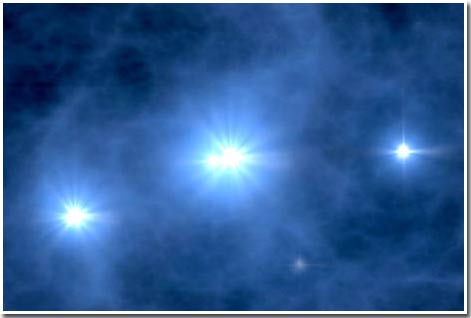The formation of 'dark stars' in the universe
A recent study found that the first stars in the universe could be gigantic but not as bright as today's stars. In essence it is called ' dark star ' and formed by the destruction of black matter.
Black matter is an invisible substance that is thought to form the early universe and play an important role in the evolution of the universe. But no hypothesis is mentioned about the black substance that formed the first stars of the galaxy.
The process is different
A common assumption of star formation is that hydrogen and helium gas molecules bind and swirl back into clouds. When these gas clouds cool, they shrink and become denser. The process continued until both hydrogen and helium gas began to ignite and produce energies like that of the sun and other stars.
According to a new study published in the January issue of Physical Review Letters , astrophysicists understand how black matter influences the temperature and density of gases that make up stars. Firstly.
The researchers assumed that black matter molecules interacted and " destroyed " each other, producing its quark and antimatter molecules, antiquark. This process produces heat, keeping the hydrogen and helium clouds from cooling and shrinking, preventing reactions from burning and producing heat.

(Artwork: NASA)
According to the University of Utah research leader Paolo Gondolo, heat production can neutralize the heat dissipation process. Therefore, a star does not shrink and creates a ' dark star ' about 80 to 100 million years after the Big Bang.
The difference in the structure of ' dark stars '.
" Dark stars " also contain common substances in the form of hydrogen and helium molecules, but are usually 400 to 200,000 times larger than other stars and " porous ".
Gondolo said that ' dark stars ' still exist, although they do not emit ordinary light rays, instead of gamma rays, neutrinos and antimatter such as positrons and antipositrons. People can't see ' dark stars ' with their naked eyes, but radiation from these stars carries tremendous heat. Gondolo believes that the discovery of this work will uncover the mysteries of star formation and help scientists learn more about the nature of black matter.
- Dark Star - Gift from the Universe
- Discover the dark age of the universe
- The reason for space is dark despite many stars shining
- The formation of the star is 300 times brighter than the Sun.
- Find places to produce stars in the universe
- New explanation of the origin of dark matter
- The 84 million star image is at the center of the universe
- Publish the world's first dark matter map
- Found signs of dark matter
- Evidence of life may exist in the parallel universe
- The mystery of dark energy
- Manufacturing of XMASS dark matter testing equipment
 Van Allen's belt and evidence that the Apollo 11 mission to the Moon was myth
Van Allen's belt and evidence that the Apollo 11 mission to the Moon was myth The levels of civilization in the universe (Kardashev scale)
The levels of civilization in the universe (Kardashev scale) Today Mars, the sun and the Earth are aligned
Today Mars, the sun and the Earth are aligned The Amazon owner announced a secret plan to build a space base for thousands of people
The Amazon owner announced a secret plan to build a space base for thousands of people NASA discovers two stars colliding so violently that they created gold
NASA discovers two stars colliding so violently that they created gold  James Webb Telescope Discovers Massive Supercluster Hidden Deep in the Milky Way
James Webb Telescope Discovers Massive Supercluster Hidden Deep in the Milky Way  'Time travel' 13.5 billion years, NASA telescope finds 4 cosmic ancestors
'Time travel' 13.5 billion years, NASA telescope finds 4 cosmic ancestors  Why there are no stars in American photos of the Moon
Why there are no stars in American photos of the Moon  Aliens control the fastest moving stars in the galaxy?
Aliens control the fastest moving stars in the galaxy?  First 'hybrid' star and planet object revealed outside the Milky Way
First 'hybrid' star and planet object revealed outside the Milky Way 